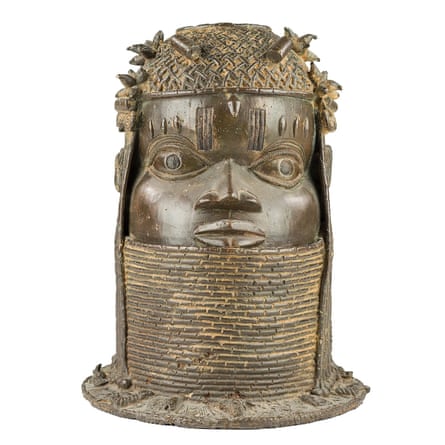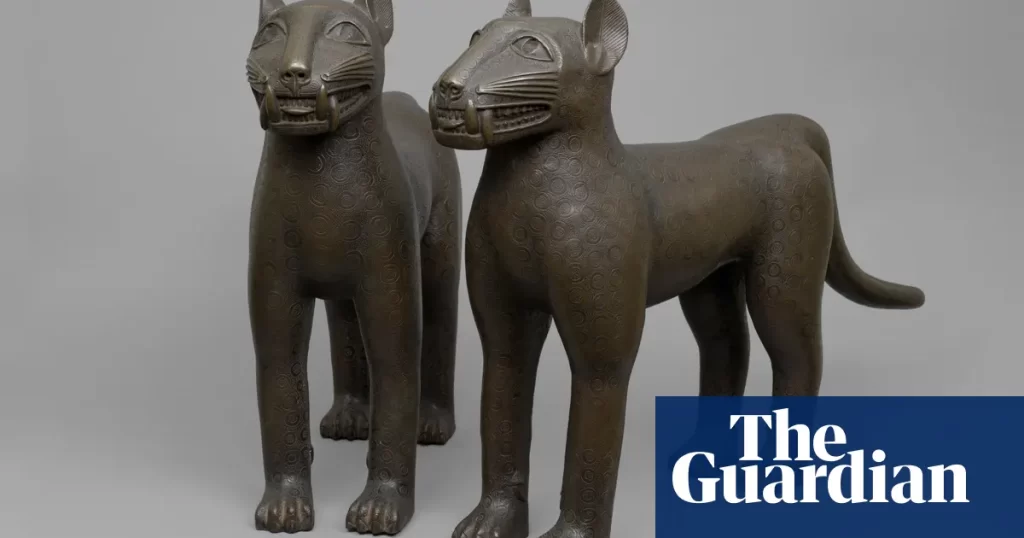- Comprehensive database of Benin bronzes held by museums raises questions about where they belong
By Philip Oltermann in Berlin, @philipoltermannThu 10 Nov 2022
Cheerfully gnashing their magnificent fangs as they stand side by side, the two bronze leopards look back on a journey that was as adventurous as it was cruelly absurd.
Looted by British soldiers on a punitive expedition to the west African kingdom of Benin in 1897, the bronzes were shipped to the UK, where they spent some time guarding the fireplace of army captain George William Neville’s Weybridge home. They were later put in display at Moma in New York and bought by a French art collector – who eventually sold them back to the colonial administration in Lagos in 1952 with a considerable mark-up.
The ekpen, or leopard figures, are two of 5,240 objects that were scattered across museums in Europe and North America after the British looting expedition but have now been reunited for the first time in one digital space.
Digital Benin, the result of a two-year €1.5m (£1.3m) international research project funded by the Ernst von Siemens art foundation, is the first comprehensive database of artefacts collectively known as the Benin bronzes.

Commemorative Head of an Oba. Photograph: Martin Lutze/Staatliche Kunstsammlungen Dresden
By stitching together about 12,000 images and information provided by 131 museums in 20 countries, the database not only charts the often winding provenance the objects’ European and American holders have in the past been coy about making public.
It also presents the artefacts in the context of the founders of the Benin empire, grouping them according to significance and ceremonial function in Edo culture.
“I have always had this longing to learn the culture of my people”, said, Osaisonor Godfrey Ekhator-Obogie, historian and project research lead at a launch event in Berlin on Wednesday. “Every bronze plaque that you see here was a page in the history of Benin.”
Relief plaque: King with two dignitaries Photograph: Paul Schimweg/Museum am Rothenbaum
While Digital Benin does not yet include some bronzes held in private collections, the project’s organisers said their database was comprehensive. “We likely haven’t captured 100%, but I am confident it is 99%,” said Barbara Plankensteiner, the project’s principal investigator and director of Hamburg’s Museum am Rothenbaum.
Participants in the project include institutions that have recently returned Benin bronzes to Nigeria or vowed to do so in the near future – including Berlin’s Ethnological Museum, Washington’s Smithsonian Institution and Oxford and Cambridge universities – as well as those which are withstanding restitution claims.
The British Museum, the holder the highest number of pieces from Benin, is prohibited from permanently removing items from its collection under a 1963 UK law.
Memorial Head Queen Mother. Photograph: Jürgen Liepe/State Museums in Berlin, Ethnological Museum.
“This platform is a knowledge-producing forum and not an instrument for restitution,” said Plankensteiner. “But it shows the objects’ local significance, how important these objects used to be, and what role they still play in ceremonial culture.”
By objectively charting provenance histories, Digital Benin indirectly raises some questions about where these objects should belong. Another pair of leopards, made of ivory with spots of inlaid copper recycled from rifle percussion caps, was presented as a gift to Queen Victoria by Adm Harry Rawson, who led the attack on Benin City on 18 February 1897 and supervised the burning of nearby chief compounds and villages.
“In Edo culture only the Oba [king] was allowed to wear ivory, so to claim it as a trophy by the British was a marker of a transfer of power,” said Felicity Bodenstein, an art historian at the Sorbonne in Paris. The two leopards remain on a long-term loan to the British Museum and are owned by King Charles III.
Bracelet: Equestrian and Standing Figure. Photograph: Public Domain
While the routes by which the Benin bronzes arrived in European or North American museum collections were rarely straightforward, Plankensteiner said it was possible to say that roughly 5,000 objects listed in the database were looted. No provenance has been identified for about 400 objects.
“This is a seed project that will help us to research networks of collecting, but also plunder and smuggling,” said Jonathan Fine, the director of Vienna’s Weltmuseum.
The digital database has funding to be updated with further archival records and photographs and ownership changes for another year, after which the organisers said they were hoping to hand it over to a suitable institution in Nigeria.
The Guardian (UK)

